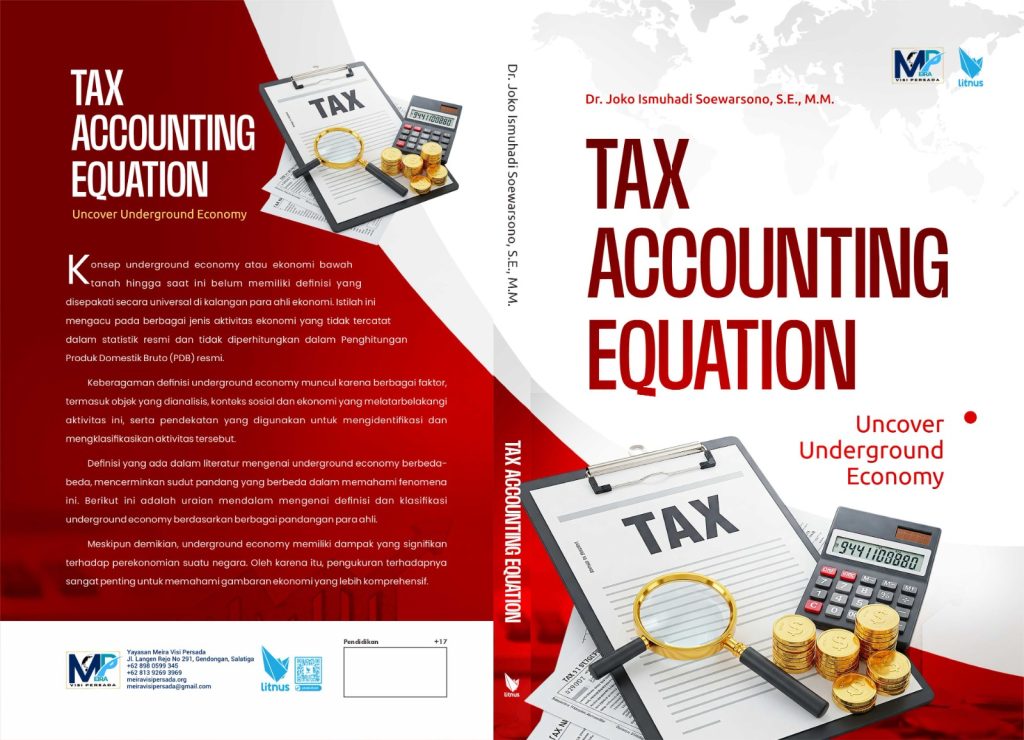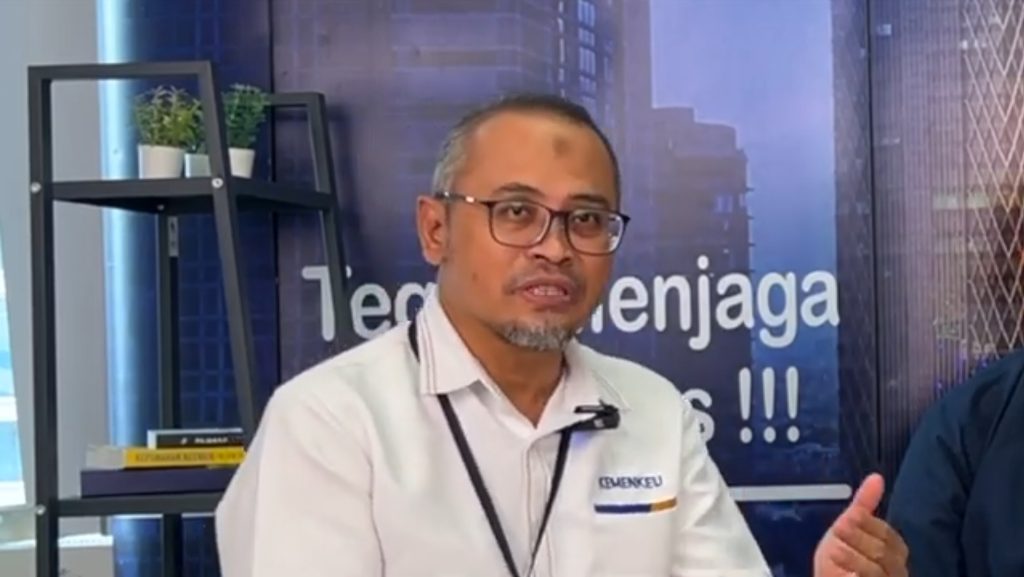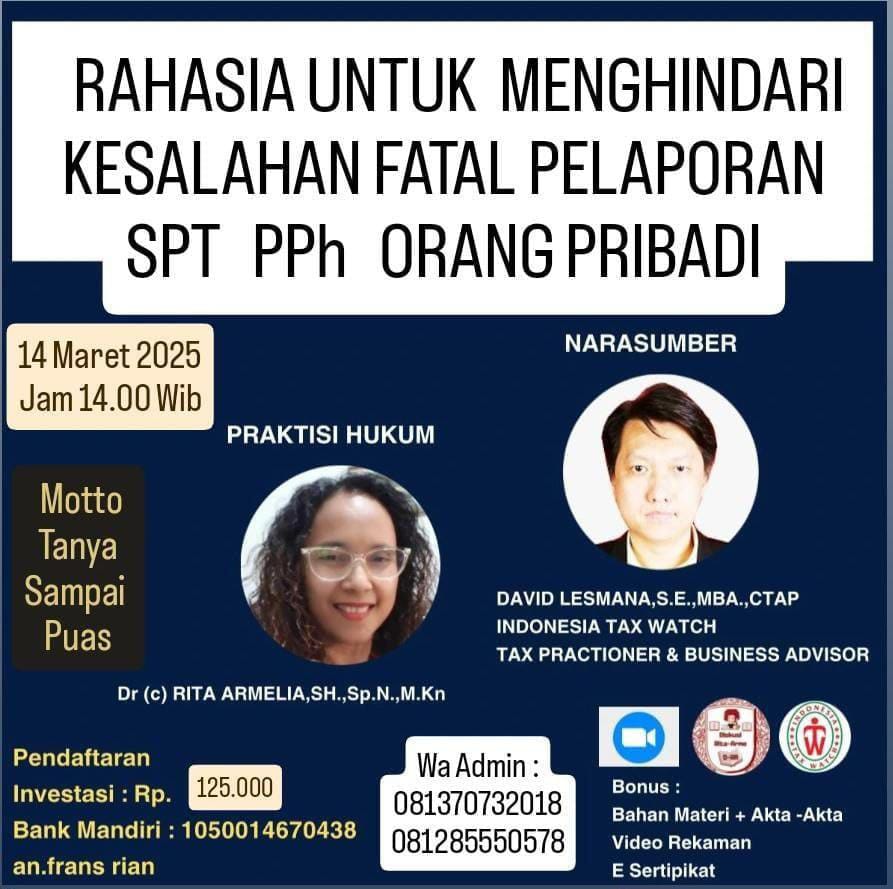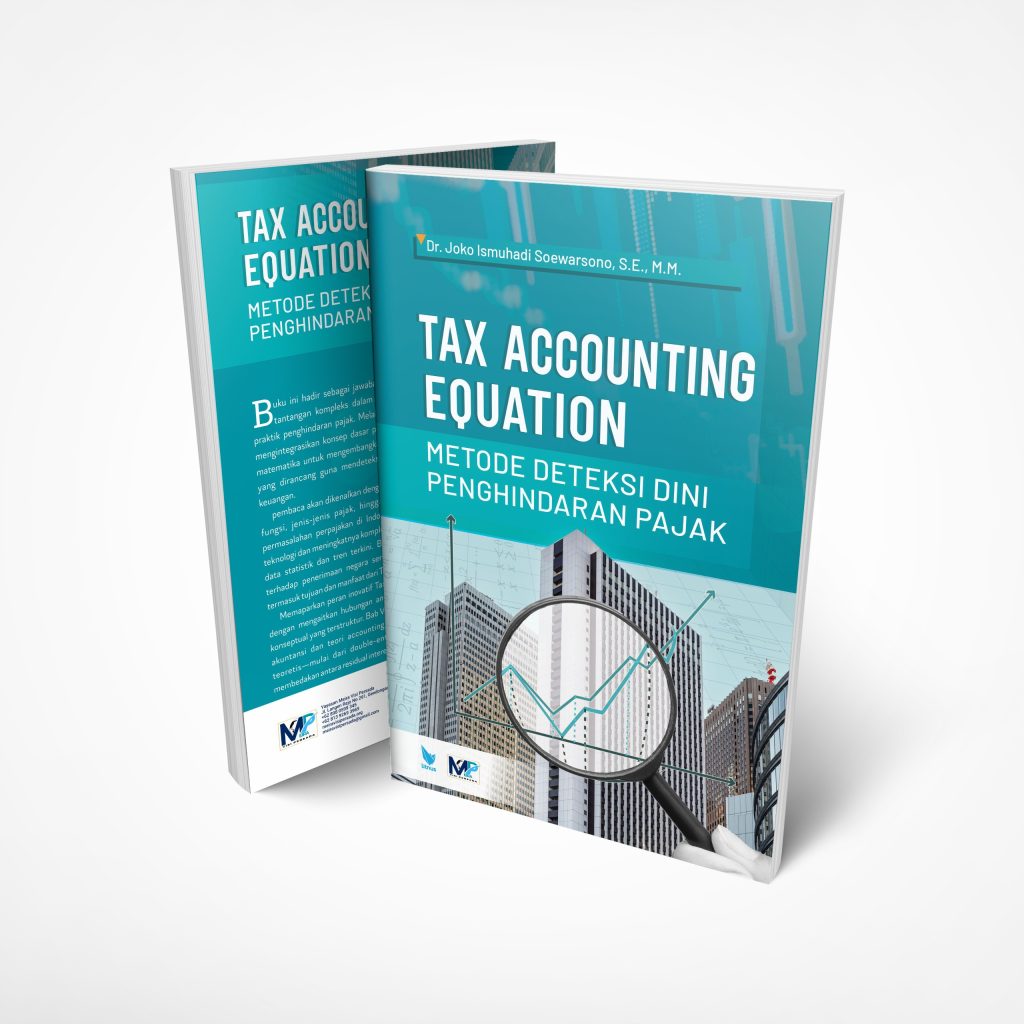
Dr. Joko Ismuhadi’s Tax Accounting Equation: A Forensic Tool for Indonesian Tax Analysis
- Ekonomi
Wednesday, 26 March 2025 04:56 WIB

Jakarta, fiskusnews.com:
The bedrock of financial analysis rests upon the fundamental accounting equation: Assets = Liabilities + Equity. This equation, also known as the balance sheet equation, serves as the cornerstone of double-entry bookkeeping, ensuring that a company’s resources are balanced against the sources of those resources. While this equation provides a crucial framework for understanding an entity’s financial position and the interplay between its assets, liabilities, and owner’s equity, its utility in specifically addressing the intricacies of tax accounting and the potential for tax avoidance or evasion is limited. The basic equation primarily focuses on the financial equilibrium of a company and does not inherently incorporate the specific elements and regulations that govern taxation.
In response to the need for a more targeted approach to tax analysis, Dr. Joko Ismuhadi Soewarsono has developed the concept of a “Tax Accounting Equation (TAE)”. This concept, attributed to Dr. Ismuhadi, aims to provide a specialized tool for understanding and potentially detecting tax irregularities, particularly within the Indonesian fiscal landscape. The development of such a tool is particularly relevant given the increasing global emphasis on combating tax fraud and ensuring compliance. Forensic accounting, a field dedicated to investigating financial discrepancies and illegal activities, plays a vital role in this effort. Dr. Ismuhadi’s TAE, identified as a forensic analysis tool, aligns with the principles of forensic accounting by offering a framework to scrutinize financial data with the specific intent of uncovering potential tax avoidance and evasion schemes. This report aims to delve into the various formulations of Dr. Ismuhadi’s TAE, explore his professional background and expertise in Indonesian tax accounting, analyze the relevance of TAE within the context of Indonesian tax law, and investigate its potential as a forensic tool for detecting tax irregularities.
The Foundation: Understanding the Basic Accounting Equation
The fundamental accounting equation, Assets = Liabilities + Equity, represents the core of accounting principles. Assets are defined as the economic resources owned or controlled by a company that have future economic value. These can include tangible items like cash, inventory, and equipment, as well as intangible assets such as patents and trademarks. Liabilities, on the other hand, represent a company’s financial obligations or debts to other parties, including loans, accounts payable, and deferred revenue. Equity, also known as owner’s equity or shareholder’s equity, represents the residual interest in the assets of the entity after deducting liabilities; it is the owner’s stake in the company.
This equation is intrinsically linked to the double-entry bookkeeping system, a method where every financial transaction is recorded in at least two accounts – a debit and a credit – ensuring that the accounting equation remains in balance. The principle is that for every increase on one side of the equation, there must be a corresponding increase on the other side or a decrease on the same side to maintain equilibrium. The accounting equation can be expanded to provide a more detailed view of the equity component by incorporating revenues, expenses, and dividends. The expanded form often appears as Assets = Liabilities + Owner’s Capital + Revenue – Expenses – Withdrawals (or Dividends). This expansion allows for a better understanding of how operational activities and distributions to owners affect the equity portion of the balance sheet.
Despite its fundamental importance in financial accounting, the basic accounting equation has inherent limitations when applied specifically to tax accounting. Its primary focus is on portraying a company’s financial position at a given point in time, rather than on determining tax obligations or ensuring tax compliance. The equation does not directly account for key tax-related elements such as taxable income, which is often calculated based on specific tax laws that may deviate from general accounting principles. Similarly, the basic equation does not explicitly include deductions, tax credits, or the resulting tax liabilities, which are governed by tax regulations. Consequently, while a balanced accounting equation indicates financial equilibrium, it does not guarantee that a company has accurately reported its income and expenses for tax purposes or has fully complied with tax laws. Discrepancies related to underreported income or overstated expenses, which are common tactics in tax avoidance and evasion, may not be readily apparent from the basic accounting equation alone. Therefore, the need for a specialized tool like Dr. Ismuhadi’s Tax Accounting Equation arises from the limitations of the standard equation in addressing the specific requirements of tax analysis and the detection of tax irregularities.
Unveiling Dr. Joko Ismuhadi’s Tax Accounting Equation(s)
The research material reveals several formulations associated with Dr. Joko Ismuhadi’s Tax Accounting Equation (TAE), suggesting a multifaceted approach to tax analysis. A presentation mentioned in the snippets refers to TAE in the context of financial engineering, indicating its potential application in more complex financial analyses beyond basic accounting principles. Furthermore, a document explicitly titled “Tax Accounting Equation (TAE)” is attributed to Dr. Joko Ismuhadi Soewarsono, with references to a 14-page document on Scribd likely containing further details. The term TAE is also described as a “tool” used in tax analysis during an in-house training conducted by Dr. Ismuhadi for Indonesian tax authorities.
One specific formulation of TAE is presented as Asset = Liability + Equity + {(Revenues – Expenses) – Dividend}, which can be rearranged to Asset + Dividends + Expenses = Liability + Equity + Revenues. This form appears to be a modification of the expanded accounting equation, potentially designed to analyze the flow of funds and the distribution of profits in relation to a company’s reported financial position for tax compliance purposes. Another significant formulation identified is Revenues = (negative) Liabilities. This equation suggests an inverse relationship between reported revenues and liabilities, which could serve as an indicator of potential tax evasion. The underlying theory is that companies might underreport revenue by misclassifying actual income as debt, thereby avoiding income tax obligations. This formulation was specifically discussed in the context of a corporate tax evasion case in Indonesia involving cash transactions and back-to-back loans.
Snippet S27 introduces another formulation attributed to Dr. Ismuhadi, termed “Novelty Joko,” which is Revenues = Expenses + Assets – Liabilities. This particular equation is noteworthy as it has been proposed as a basis for amending Article 4(1) of the Indonesian Income Tax Law, which defines taxable income. This suggests that Dr. Ismuhadi intends for his TAE to have practical implications for how income is defined and taxed in Indonesia, potentially aiming to broaden the definition to better capture economic capacity reflected in changes in assets and liabilities. Finally, Snippet S62 presents two equations: Mathematic Accounting Equation (MAE) : Assets + Dividend + Expenses = Liabilities + Equity + Revenues, and Tax Accounting Equation (TAE) : Revenues – Expenses. The MAE is essentially a rearrangement of the expanded accounting equation, while the TAE is the basic formula for profit. The inclusion of Revenues – Expenses as TAE might indicate a focus on the fundamental accuracy of a company’s reported profit, which is a primary basis for income tax assessment.
The existence of these multiple formulations underscores the multifaceted nature of Dr. Ismuhadi’s work on TAE. These different equations likely serve various analytical purposes, reflecting an evolving understanding or targeted applications of the TAE concept in addressing different aspects of tax analysis and compliance within the Indonesian context.
| Equation | Source Snippet(s) | Primary Focus |
|---|---|---|
| Assets + Dividends + Expenses = Liabilities + Equity + Revenues | S25, S62 | Analyzing fund flows and profit distribution in relation to financial position for tax compliance. |
| Revenues = (negative) Liabilities | S25, S29 | Detecting potential tax evasion by identifying discrepancies between reported revenue and liabilities, possibly indicating hidden income disguised as debt. |
| Revenues = Expenses + Assets – Liabilities | S27 | Proposed as a foundation for a revised definition of taxable income under Indonesian tax law, emphasizing changes in economic capacity. |
| Revenues – Expenses | S62 | Focusing on the accuracy of reported profit, which is the basis for income tax. |
Dr. Joko Ismuhadi: An Expert in Indonesian Tax Accounting
The research material consistently portrays Dr. Joko Ismuhadi as a highly experienced and knowledgeable figure in the field of Indonesian tax accounting. While an early reference identifies him as a student of Accounting Science, subsequent information reveals a robust academic and professional trajectory. He is credited as the author of a document on the Tax Accounting Equation (TAE), indicating his early and sustained engagement with this concept. His expertise is further highlighted by his role as a speaker at in-house training sessions for the Indonesian tax authorities, specifically for KPP Pratama Bandar Lampung Satu and KPP Pratama Surabaya Karangpilang. These engagements suggest that his work on TAE is recognized and considered valuable by Indonesian tax officials in their efforts to improve tax analysis and detect avoidance.
Dr. Ismuhadi holds significant academic qualifications, including a doctorate from Universitas Borobudur. More comprehensively, Snippet S27 details that he holds an SE. (Sarjana Ekonomi, Bachelor of Economics), an MM. (Magister Manajemen, Master of Management), and possesses a strong background in taxation from Sekolah Tinggi Akuntansi Negara (STAN), a prestigious finance college in Indonesia. Furthermore, he has earned a doctorate in tax accounting from Universitas Padjadjaran and another doctorate in tax law from Universitas Borobudur. This extensive academic background in both accounting and law, with a specialization in taxation, underscores his deep theoretical understanding of the subject matter.
Beyond his academic achievements, Dr. Ismuhadi is actively involved in professional organizations within Indonesia. He is a member of Perkumpulan Tax Center dan Akademisi Pajak Seluruh Indonesia (Pertapsi), an association of tax centers and tax academics across Indonesia, and Perserikatan Ahli Hukum Indonesia (Perkahi), the Indonesian Law Experts Association. His membership in these organizations signifies his engagement with both the academic and legal communities in Indonesia, further establishing his credibility as an expert. Importantly, Snippets S27 and S31 identify him as an experienced tax auditor. This practical experience in examining financial records and assessing tax compliance provides him with firsthand knowledge of tax avoidance and evasion practices within Indonesia. His insights into these real-world scenarios likely form the foundation for the development and focus of his Tax Accounting Equation as a tool for detection. The invitation to present his TAE as a means to detect tax avoidance to tax officials further solidifies his reputation as a leading expert in Indonesian tax accounting and forensic tax analysis.
The Indonesian Context: TAE and National Tax Regulations
Dr. Joko Ismuhadi’s work on the Tax Accounting Equation (TAE) appears to be closely intertwined with the Indonesian tax and regulatory environment. One of the most significant connections is the proposal to amend Article 4(1) of the Indonesian Income Tax Law based on the TAE formulation: Revenues = Expenses + Assets – Liabilities. Article 4(1) of the Income Tax Law defines “income” as the object of tax, encompassing any additional economic capacity received or obtained by a taxpayer. Dr. Ismuhadi’s proposed change suggests an intention to broaden this definition to explicitly include changes in a taxpayer’s net worth (Assets – Liabilities) as a component of income. This potential amendment aims to create a more comprehensive definition of taxable income that captures increases in economic capacity, even if not realized in cash, thereby potentially reducing opportunities for tax avoidance by focusing solely on cash-based income.
The Indonesian tax system operates on a self-assessment basis, where taxpayers are responsible for calculating and reporting their own tax obligations. Proper bookkeeping and financial reporting in accordance with Indonesian Financial Accounting Standards (Standar Akuntansi Keuangan – SAK) are mandatory for taxpayers. In this context, Dr. Ismuhadi’s TAE can be seen as an analytical tool that tax authorities can use to scrutinize these self-assessments and the underlying financial records for inconsistencies that might indicate underreported income or other forms of tax non-compliance. The TAE formulations, particularly the one highlighting the inverse relationship between revenues and liabilities (Revenues = (negative) Liabilities), provide specific lenses through which to examine financial data for potential red flags.
A practical illustration of TAE’s relevance within the Indonesian context is its application in analyzing the Duta Palma Group case. In this instance, the formulation Revenues = (negative) Liabilities was used to explain the potential tax evasion scheme involving large cash holdings and back-to-back loan transactions. The analysis suggested that the corporation might have been underreporting sales revenue by classifying the cash inflows as loan disbursements, thus avoiding corporate income tax and Value Added Tax (VAT). This real-world example demonstrates the potential of TAE to address specific tax evasion tactics that may be prevalent in the Indonesian business environment, particularly those involving cash-intensive operations and complex financial arrangements. The fact that Dr. Ismuhadi’s work is presented to and considered by Indonesian tax authorities further underscores its direct relevance and potential impact on national tax regulations and enforcement.
Forensic Applications of TAE: Detecting Tax Avoidance and Evasion
Dr. Joko Ismuhadi’s Tax Accounting Equation (TAE) is explicitly identified as a tool for tax analysis and, more specifically, as an early detection tool for corporate taxpayers engaged in tax avoidance and/or evasion. It is also directly labeled as a forensic analysis tool designed to uncover inconsistencies in financial reports and a new instrument for detecting tax avoidance or evasion. These descriptions firmly establish TAE’s intended application within the realm of forensic accounting, which plays a critical role in identifying financial statement manipulation and tax fraud.
One of the key forensic applications of TAE lies in its ability to analyze the interrelationships between fundamental accounting elements such as revenues, expenses, assets, liabilities, equity, and dividends. By examining these relationships through the specific formulations of TAE, forensic accountants can gain a more holistic view of a company’s financial data and potentially identify anomalies or unusual patterns that might indicate intentional misreporting for tax purposes. For instance, the formulation Revenues = (negative) Liabilities provides a specific framework for scrutinizing situations where a high level of reported liabilities might be masking underreported revenues. This could be particularly relevant in industries or transactions where cash is a significant medium of exchange or where complex financing arrangements are used.
Snippet S32 highlights a specific forensic application of TAE, suggesting that by focusing audit efforts on corporate debt accounts in combination with foreign exchange transactions, tax avoidance or evasion can be detected. This implies that Dr. Ismuhadi’s TAE framework might incorporate principles or analytical techniques specifically designed to identify how companies could be using debt financing and cross-border financial flows to reduce their tax liabilities. For example, TAE could assist in identifying instances where funds transferred to related parties offshore are disguised as loan repayments rather than dividends, or where foreign exchange transactions are used to shift profits to lower-tax jurisdictions.
The role of forensic accounting, as supported by tools like TAE, is crucial in combating financial crimes, including tax fraud. By providing a structured analytical framework that goes beyond the basic accounting equation, TAE empowers forensic accountants to delve deeper into financial data, identify inconsistencies, and ultimately uncover potential instances of tax avoidance and evasion that might otherwise remain undetected through traditional audit methods. The focus on specific relationships, such as that between revenues and liabilities or the analysis of debt and foreign exchange transactions, allows for a more targeted and potentially more effective approach to forensic tax investigations.
TAE and the Underground Economy in Indonesia
Dr. Joko Ismuhadi’s work on the Tax Accounting Equation (TAE) also appears to extend to the analysis of the underground economy in Indonesia, as indicated by the mention of “Underground Economy Activity” in relation to one of his presentations. The underground economy, also referred to as the informal, shadow, or hidden economy, encompasses economic activities that are concealed from official authorities for various reasons, including tax evasion. Tax evasion is indeed a key characteristic of the underground economy, as unreported income from these activities leads to a direct loss of tax revenue for the government. Measuring and taxing the underground economy presents significant challenges due to its very nature of being hidden and undocumented. Traditional macroeconomic indicators and national income accounting often fail to fully capture the scale and impact of this sector.
While the research snippets do not provide a specific formulation of TAE tailored for analyzing the underground economy, Dr. Ismuhadi’s recognition of this connection suggests that his framework might offer valuable insights into detecting tax evasion in sectors characterized by cash-intensive transactions and informal operations. Given the difficulty in obtaining direct financial data from underground economic activities, TAE could potentially be applied as a macro-level analytical tool. By examining aggregate financial data and identifying anomalies or trends that might correlate with increased informal economic activity, tax authorities could gain a better understanding of the scale of tax evasion within this sector.
For instance, significant discrepancies between overall reported income and total expenditure at a national level, or unusual increases in currency circulation that cannot be explained by formal economic activity, might be analyzed through the lens of TAE to infer the potential size and impact of the underground economy on tax revenues. Dr. Ismuhadi’s approach might involve adapting the existing TAE formulations or developing new ones that focus on identifying indirect indicators of unreported economic activity and related tax evasion. This could be particularly relevant in the Indonesian context, where the informal sector plays a significant role in the overall economy. By providing a framework for analyzing these indirect indicators, TAE could assist tax authorities in developing more effective strategies to address tax compliance within the underground economy, even in the absence of detailed financial records for individual operators.
Conclusion: Significance and Future Implications of TAE
Dr. Joko Ismuhadi’s Tax Accounting Equation (TAE) represents a notable contribution to the field of tax accounting, particularly within the Indonesian context. His work offers a specialized framework for analyzing financial data with a specific emphasis on detecting tax irregularities, going beyond the limitations of the basic accounting equation. Dr. Ismuhadi’s extensive academic and practical background in Indonesian tax law and forensic accounting positions him as a credible authority in this area. The various formulations of TAE identified in the research suggest a multifaceted approach to tax analysis, tailored to address different aspects of tax compliance and potential evasion schemes.
The relevance of TAE to Indonesian tax law is evident in the proposal to amend Article 4(1) of the Income Tax Law based on one of its formulations. This indicates Dr. Ismuhadi’s intention for TAE to have practical implications for how income is defined and taxed in Indonesia. Furthermore, the application of TAE in analyzing specific cases of corporate tax evasion, such as the Duta Palma Group, demonstrates its potential as a forensic tool for uncovering tax irregularities in real-world scenarios. The recognition of TAE by Indonesian tax authorities, as evidenced by Dr. Ismuhadi’s role in conducting in-house training sessions, underscores its perceived value in enhancing tax analysis and detection capabilities.
Looking ahead, the continued exploration and application of TAE hold significant potential for improving tax compliance and revenue collection in Indonesia. Further research could focus on empirically validating the effectiveness of the different TAE formulations in identifying various types of tax avoidance and evasion. Refining these formulations for specific applications, such as analyzing the underground economy or complex financial transactions, could also enhance their utility. Ultimately, Dr. Ismuhadi’s Tax Accounting Equation offers a promising avenue for strengthening tax enforcement and promoting greater fiscal transparency in Indonesia.
Reporter: Marshanda Gita – Pertapsi Muda
Share
Berita Lainnya
Core Tax: Paymeny Gate Way Tax Multi Billing
Interpretasi Pasal 33 Ayat 3 UUD 1945 dan Dampaknya terhadap Pasar Tanah di Indonesia
Menggali Potensi Pajak Indonesia: Relevansi Persamaan Ismuhadi di Sektor Ekonomi Bayangan Tinggi
IAI KAPj 𝘎𝘖𝘌𝘚 𝘛𝘖 𝘊𝘈𝘔𝘗𝘜𝘚
Leveraging STEM to Enhance Tax Revenue Collection from Indonesia’s Underground Economy
Persamaan Akuntansi Pajak Dr. Joko Ismuhadi: Alat Forensik untuk Analisis Pajak Indonesia
Webinar “Rahasia Menghindari Kesalahan Fatal Pelaporan SPT PPh Orang Pribadi”
Rekomendasi untuk Anda

Berita Terbaru
Eksplor lebih dalam berita dan program khas fiskusnews.com
Tag Terpopuler
# #TAE
# #TAX ACCOUNTING EQUATION
# #TAX FRAUD
# #TAX EVASION












